
Employee API | Administrative - SOAP
The Employee Service provides clients employee functionalities such as reading, adding, updating, and deleting employees’ information.
Important Note: In order to facilitate backward compatibility with all Web Services in use prior to June 4, 2005, either Employee (Dependent) Social Security Number (previously used as unique employee/dependent Identifier) or Employee (Dependent) ID (new unique employee/dependent Identifier) may be provided when required to uniquely Identify an employee or dependent. If both are provided, the Employer (Dependent) ID is used as the unique Identifier. When adding or updating employee or dependent demographic information (specifically, the “True” Social Security Number field), the following rules apply:
If only the Employee (Dependent) ID is provided, it is used as the unique Identifier, and the “True” SSN field is not added or updated.
If only the Employee (Dependent) Social Security Number is provided, it is used as the unique Identifier, and the “True” SSN field is not added or updated.
If both the Employee (Dependent) ID and the Employee (Dependent) Social Security Number are provided, the Employee (Dependent) ID is used as the unique Identifier and the Employee (Dependent) Social Security Number is used to add or update the “True” SSN.
Service Web Methods
The following is a list of methods that are provided by the Employee Service.
AddEmployee – used to add an employee’s demographic information and to check routing.
DeleteEmployee – used to remove information about an employee.
GetEmployee – used to retrieve an employee’s demographic information and to check routing.
UpdateEmployee – used to update an employee’s demographic information and to check routing.
SearchEmployees - used to retrieve an employee's demographic information and to check routing.
UpdateEmployeeHumanResourceInfo – used for updating an employee’s non-discriminatory information.
GetEmployeeHumanResourceInfo – used for retrieving an employee’s non-discriminatory information.
AddEmployeeInteraction - This method is used to add new employee interactions.
Service Assumptions/Business Rules
The Employee Service makes the following assumptions as well as enforces the following business rules.
9 TClients shall conform to the WS-I specifications unless otherwise agreed upon by Alegeus Technologies and the 9 T administrator.
Clients shall format SOAP messages in a Document/Literal format over HTTPS.
Clients shall have already created a valid user ID and password.
Clients shall have a valid session ID after being authenticated by the system. The session ID needs to be passed in the proper manner as described in the Account Manager Service Guide.
If the administrator uses the same user ID and password for all of their clients, the administrator is responsible for managing the security of the data.
Clients should validate data before submitting a request to this Service. This facilitates better performance and accurate processing on both systems.
Clients shall not attempt to use this service for batch processing of large amounts of data. The service is designed for synchronous calls that send or retrieve small chunks of data. If batch processing is required, then the EDI process should be used.
If any method fails, the service returns a SOAP fault describing the problem.
__________________________________________________
AddEmployee
This method is used to add an employee’s demographic information and to check routing.
History
The AddEmployee methods are listed below:
Request Message
AddEmployee_2022_10
AddEmployee_2015_02
AddEmployee_2012_06
AddEmployee_2009_04
AddEmployee_2008_07
AddEmployee_2007_12
AddEmployeeRequest
Response Message
AddEmployeeResponse
AddEmployee Request/Response Messages
The AddEmployee method requires the following request and response messages (input and output data). The table below includes the following request message:
AddEmployee_2009_04
AddEmployee_2008_07
AddEmployee_2007_12
AddEmployeeRequest

Example of an AddEmployee SOAP request message
<?xml version="1.0" encoding="utf-8" ?>
<soap:Envelope xmlns:soap="http://schemas.xmlsoap.org/soap/envelope/"
xmlns:xsi="http://www.w3.org/2001/XMLSchema-instance"
xmlns:xsd="http://www.w3.org/2001/XMLSchema">
<soap:Header>
<MBISessionHeader xmlns="http://www.medibank.com/MBIWebServices/SoapHeader/">
<MBISessionID>jhcppu45zzo00y45cqi03r55</MBISessionID>
</MBISessionHeader>
</soap:Header>
<soap:Body>
<AddEmployee xmlns="http://www.medibank.com/MBIWebServices/Employee/Messages/Employee/Request/2004/06/">
<addEmployeeRequest>
<Address1>123 EasternGirls St</Address1>
<BankAccount>123456</BankAccount>
<BankAccountTypeCode xmlns="http://www.medibank.com/MBIWebServices/Enums/">Checking</BankAccountTypeCode>
<BankRoutingNumber>123456789</BankRoutingNumber>
<BirthDate>1945-01-01</BirthDate>
<City>WesternWorld</City>
<EmailAddress />
<EmployeeSocialSecurityNumber>444555666</EmployeeSocialSecurityNumber>
<EmployerId>EASE10</EmployerId>
<FirstName>Pet</FirstName>
<Gender xmlns="http://www.medibank.com/MBIWebServices/Enums/">Male</Gender>
<LastName>Shop</LastName>
<EmployeeMaritalStatus
xmlns="http://www.medibank.com/MBIWebServices/Enums/">Divorced</EmployeeMaritalStatus>
<MiddleInitial />
<NamePrefix>Mr.</NamePrefix>
<Phone />
<ReimbursementCode xmlns="http://www.medibank.com/MBIWebServices/Enums/">Check</ReimbursementCode>
<Remarks>This is a test</Remarks>
<ShippingCountry />
<State>MA</State>
<TpaId>T00209</TpaId>
<ZipCode>12345</ZipCode>
</addEmployeeRequest>
</AddEmployee>
</soap:Body>
</soap:Envelope>
Example of an AddEmployee SOAP response message
<?xml version="1.0" encoding="utf-8" ?>
<soap:Envelope xmlns:soap="http://schemas.xmlsoap.org/soap/envelope/"
xmlns:xsi="http://www.w3.org/2001/XMLSchema-instance"
xmlns:xsd="http://www.w3.org/2001/XMLSchema">
<soap:Header>
<MBIMessageIdHeader xmlns="http://www.medibank.com/MBIWebServices/SoapHeader/" />
</soap:Header>
<soap:Body>
<AddEmployeeResponse
xmlns="http://www.medibank.com/MBIWebServices/Employee/Messages/Employee/Response/2004/06/">
<AddEmployeeResult />
</AddEmployeeResponse>
</soap:Body>
</soap:Envelope>
Example Client Code
The following is an example of the client code (using a .NET proxy class for accessing the service) using the AddEmployee web method.
try
{
// Create the session SOAP header in order to pass the Account Service
// the client’s current session ID.
mbiSessionHeader = new EmployeeServiceNameSpace.MBISessionHeader();
// Create proxy object for the Employee service
proxy = new EmployeeServiceNameSpace.EmployeeService();
// Create request message for method call (input parameters)
request = new EmployeeServiceNameSpace.AddEmployeeRequest();
// Set the input parameters
request.Address1 = _address1.Text;
request.Address2 = _address2.Text;
request.BankAccount = _bankAccount.Text;
request.BankAccountTypeCode = (EmployeeServiceNameSpace.BankAccountType)
_bankAccountTypeCode.SelectedItem;
request.BankRoutingNumber = _bankRoutingNumber.Text;
if(_birthDate.Text.Length > 0)
{
request.BirthDate = Convert.ToDateTime(_birthDate.Text);
}
request.City = _city.Text;
request.Country = _country.Text;
request.EmailAddress = _email.Text;
request.EmployeeMaritalStatus = (EmployeeServiceNameSpace.MaritalStatus)
_maritalStatus.SelectedItem;
request.EmployeeSocialSecurityNumber = _empeSSN.Text;
request.EmployerId = _emprId.Text;
request.FirstName = _firstName.Text;
request.Gender = (EmployeeServiceNameSpace.Gender)_gender.SelectedItem;
request.LastName = _lastName.Text;
request.MiddleInitial = _initial.Text;
request.NamePrefix = _namePrefix.Text;
request.Phone = _phone.Text;
request.ReimbursementCode = (EmployeeServiceNameSpace.ReimbursementMethod)
_reimbursementCode.SelectedItem;
request.Remarks = _remarks.Text;
request.ShippingAddress1 = _shippingAddress1.Text;
request.ShippingAddress2 = _shippingAddress2.Text;
request.ShippingCity = _shippingCity.Text;
request.ShippingCountry = _shippingCountry.Text;
request.ShippingState = _shippingState.Text;
request.ShippingZipCode = _shippingZip.Text;
request.State = _state.Text;
request.TpaId = _tpaId.Text;
request.UserDefinedField = _userDefinedField.Text;
request.ZipCode = _zipCode.Text;
// session ID returned from login method
mbiSessionHeader.MBISessionID = _sessionId.Text;
proxy.MBISessionHeaderValue = mbiSessionHeader;
// Call the method
response = proxy.AddEmployee(request);
MessageBox.Show("Finished.");
}
catch(SoapException se)
{
// perform needed operations
}
catch(Exception ex)
{
// perform needed operations
}
__________________________________________________
DeleteEmployee
This method is used to delete information about an employee from the system.
History
The DeleteEmployee methods are listed below:
Request Message
DeleteEmployeeRequest
Response Message
DeleteEmployeeResponse
DeleteEmployee Request/Response Messages
The DeleteEmployee method requires the following request and response messages (input and output data). The table below includes the following request message:
DeleteEmployeeRequest

Response Message: Empty Message
Example of a DeleteEmployee SOAP request message
<?xml version="1.0" encoding="utf-8" ?>
<soap:Envelope xmlns:soap="http://schemas.xmlsoap.org/soap/envelope/"
xmlns:xsi="http://www.w3.org/2001/XMLSchema-instance"
xmlns:xsd="http://www.w3.org/2001/XMLSchema">
<soap:Header>
<MBISessionHeader xmlns="http://www.medibank.com/MBIWebServices/SoapHeader/">
<MBISessionID>jhcppu45zzo00y45cqi03r55</MBISessionID>
</MBISessionHeader>
</soap:Header>
<soap:Body>
<DeleteEmployee xmlns="http://www.medibank.com/MBIWebServices/Employee/Messages/Employee/Request/2004/06/">
<deleteEmployeeRequest>
<EmployeeSocialSecurityNumber>444555666</EmployeeSocialSecurityNumber>
<EmployerId>EASE10</EmployerId>
<TpaId>T00209</TpaId>
</deleteEmployeeRequest>
</DeleteEmployee>
</soap:Body>
</soap:Envelope>
Example of a DeleteEmployee SOAP response message
<?xml version="1.0" encoding="utf-8" ?>
<soap:Envelope xmlns:soap="http://schemas.xmlsoap.org/soap/envelope/"
xmlns:xsi="http://www.w3.org/2001/XMLSchema-instance"
xmlns:xsd="http://www.w3.org/2001/XMLSchema">
<soap:Header>
<MBIMessageIdHeader xmlns="http://www.medibank.com/MBIWebServices/SoapHeader/" />
</soap:Header>
<soap:Body>
<DeleteEmployeeResponse
xmlns="http://www.medibank.com/MBIWebServices/Employee/Messages/Employee/Response/2004/06/"> <DeleteEmployeeResult />
</DeleteEmployeeResponse>
</soap:Body>
</soap:Envelope>
Example Client Code
The following is an example of the client code (using a .NET proxy class to connect with the service) used when calling the DeleteEmployee method.
try
{
// Create the session SOAP header in order to pass the Account Service
// the client’s current session ID.
mbiSessionHeader = new EmployeeServiceNameSpace.MBISessionHeader();
// Create proxy object for the Employee service
proxy = new EmployeeServiceNameSpace.EmployeeService();
// Create request message for method call (input parameters)
request = new EmployeeServiceNameSpace.DeleteEmployeeRequest();
// Set the input parameters
request.EmployeeSocialSecurityNumber = _employeeSocialSecurityNumber.Text;
request.EmployerId = _employerId.Text;
request.TpaId = _tpaId.Text;
// session ID returned from login method
mbiSessionHeader.MBISessionID = _sessionId.Text;
proxy.MBISessionHeaderValue = mbiSessionHeader;
// Call the method
response = proxy.DeleteEmployee(request);
MessageBox.Show("Finished.");
}
catch(SoapException se)
{
// perform needed operations
}
catch(Exception ex)
{
// perform needed operations
}
__________________________________________________
GetEmployee
This method is used to retrieve an employee’s demographic information and to check routing.
History
The GetEmployee methods are listed below:
Request Message
GetEmployeeRequest
Response Message
GetEmployeeResponse_2012_06
GetEmployeeResponse_2009_04
GetEmployeeResponse_2008_07
GetEmployeeResponse_2007_12
GetEmployeeResponse
GetEmployee Request/Response Messages
The GetEmployee method requires the following request and response messages (input and output data). The table below includes the following request message:
GetEmployeeRequest

The table below includes the following response message:
GetEmployeeResponse_2009_04
GetEmployeeResponse_2007_12
GetEmployeeResponse

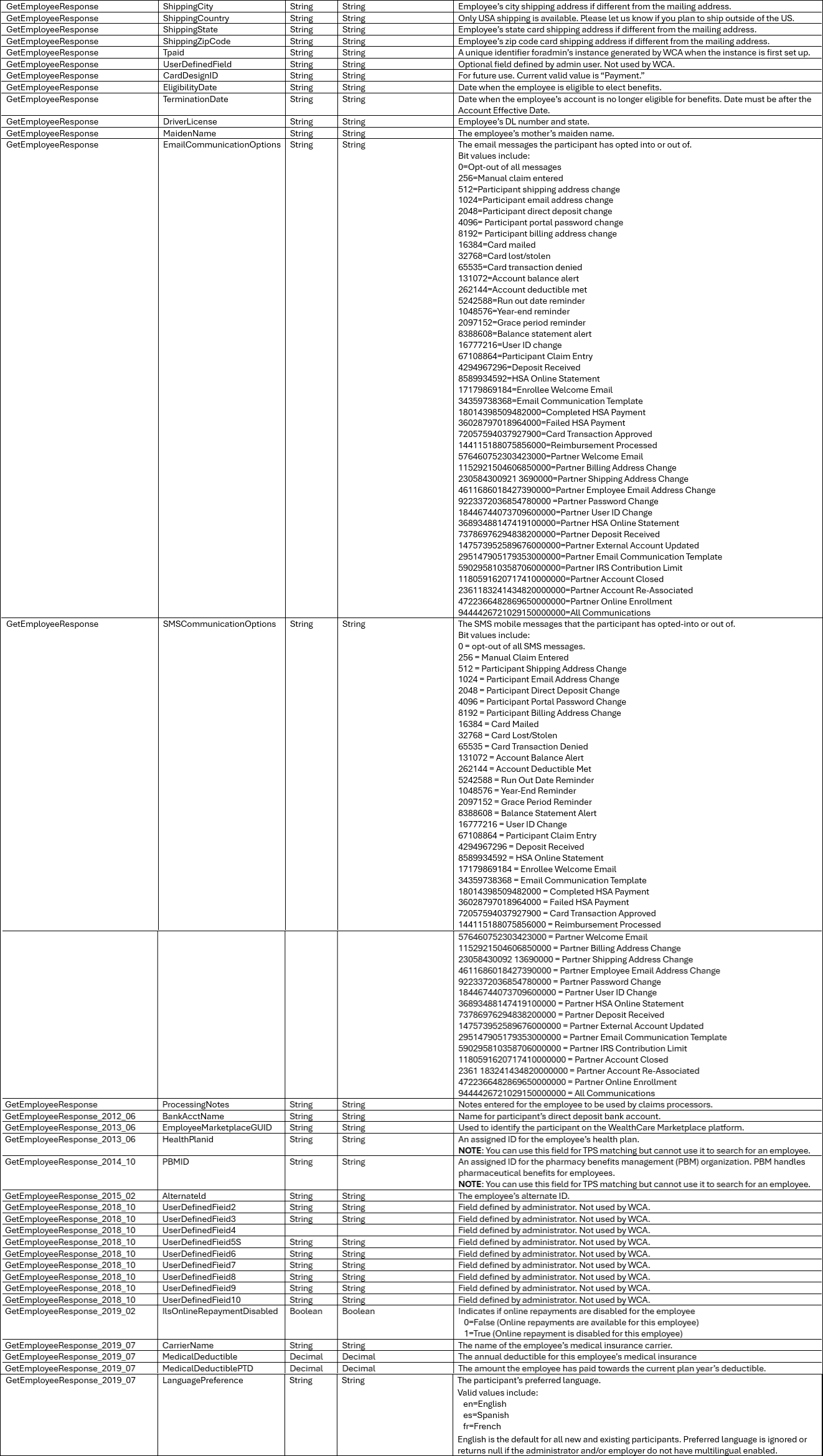
Example of a GetEmployee SOAP request message
<?xml version="1.0" encoding="utf-8" ?>
<soap:Envelope xmlns:soap=http://schemas.xmlsoap.org/soap/envelope/
xmlns:xsi="http://www.w3.org/2001/XMLSchema-instance"
xmlns:xsd="http://www.w3.org/2001/XMLSchema">
<soap:Header>
<MBISessionHeader xmlns="http://www.medibank.com/MBIWebServices/SoapHeader/">
<MBISessionID>jhcppu45zzo00y45cqi03r55</MBISessionID>
</MBISessionHeader>
</soap:Header>
<soap:Body>
<GetEmployee xmlns="http://www.medibank.com/MBIWebServices/Employee/Messages/Employee/Request/2004/06/">
<getEmployeeRequest>
<EmployeeSocialSecurityNumber>444555666</EmployeeSocialSecurityNumber>
<EmployerId>EASE10</EmployerId>
<TpaId>T00209</TpaId>
</getEmployeeRequest>
</GetEmployee>
</soap:Body>
</soap:Envelope>
Example of a GetEmployee SOAP response message
<?xml version="1.0" encoding="utf-8" ?>
<soap:Envelope xmlns:soap=http://schemas.xmlsoap.org/soap/envelope/
xmlns:xsi="http://www.w3.org/2001/XMLSchema-instance"
xmlns:xsd="http://www.w3.org/2001/XMLSchema">
<soap:Header>
<MBIMessageIdHeader xmlns="http://www.medibank.com/MBIWebServices/SoapHeader/" />
</soap:Header>
<soap:Body>
<GetEmployeeResponse
xmlns="http://www.medibank.com/MBIWebServices/Employee/Messages/Employee/Response/2004/06/">
<GetEmployeeResult>
<Address1>123 EasternGirls St</Address1>
<Address2 />
<BankAccount>123456</BankAccount>
<BankAccountTypeCode xmlns="http://www.medibank.com/MBIWebServices/Enums/">Checking</BankAccountTypeCode>
<BankRoutingNumber>123456789</BankRoutingNumber>
<BirthDate>19450101</BirthDate>
<City>WesternWorld</City>
<Country>US</Country>
<EmailAddress />
<EmployeeSocialSecurityNumber>444555666</EmployeeSocialSecurityNumber>
<EmployeeStatus xmlns="http://www.medibank.com/MBIWebServices/Enums/">New</EmployeeStatus>
<EmployerId>EASE10</EmployerId>
<FirstName>Pet</FirstName>
<Gender xmlns="http://www.medibank.com/MBIWebServices/Enums/">Male</Gender>
<LastName>Shop</LastName>
<EmployeeMaritalStatus xmlns="http://www.medibank.com/MBIWebServices/Enums/">Divorced</EmployeeMaritalStatus>
<MiddleInitial />
<NamePrefix>Mr.</NamePrefix>
<Phone />
<ReimbursementCode xmlns="http://www.medibank.com/MBIWebServices/Enums/">Check</ReimbursementCode>
<Remarks>This is a test</Remarks>
<ShippingAddress1 />
<ShippingAddress2 />
<ShippingCity />
<ShippingCountry />
<ShippingState />
<ShippingZipCode />
<State>MA</State>
<TpaId>T00209</TpaId>
<UserDefinedField />
<ZipCode>12345</ZipCode>
</GetEmployeeResult>
</GetEmployeeResponse>
</soap:Body>
</soap:Envelope>
Example Client Code
The following is an example of the client code (using a .NET proxy class to connect to the service) used when calling the GetEmployee method.
try
{
_dataset.Tables["Employees"].Clear();
// Create the session SOAP header in order to pass the Account Service
// the client’s current session ID.
mbiSessionHeader = new EmployeeServiceNameSpace.MBISessionHeader();
// Create proxy object for the Employee service
proxy = new EmployeeServiceNameSpace.EmployeeService();
// Create request message for method call (input parameters)
request = new EmployeeServiceNameSpace.GetEmployeeRequest();
// Set the input parameters
request.EmployeeSocialSecurityNumber = _employeeSocialSecurityNumber.Text;
request.EmployerId = _employerId.Text;
request.TpaId = _tpaId.Text;
request.VerboseMode = Convert.ToBoolean(_verboseMode.Text);
// session ID returned from logon method
mbiSessionHeader.MBISessionID = _sessionId.Text;
proxy.MBISessionHeaderValue = mbiSessionHeader;
response = proxy.GetEmployee(request);
if(response != null)
{
_dataset.Tables["Employees"].Rows.Add(new string[]
{
response.Address1,
response.Address2,
response.BankAccount,
response.BankAccountTypeCode.ToString(),
response.BankRoutingNumber,
response.BirthDate,
response.City,
response.Country,
response.EmailAddress,
response.EmployeeMaritalStatus.ToString(),
response.EmployeeSocialSecurityNumber,
response.EmployeeStatus.ToString(),
response.EmployerId,
response.FirstName,
response.Gender.ToString(),
response.LastName,
response.MiddleInitial,
response.NamePrefix,
response.Phone,
response.ReimbursementCode.ToString(),
response.Remarks,
response.ShippingAddress1,
response.ShippingAddress2,
response.ShippingCity,
response.ShippingCountry,
response.ShippingState,
response.ShippingZipCode,
response.State,
response.TpaId,
response.UserDefinedField,
response.ZipCode
});
}
}
catch(SoapException se)
{
// perform needed operations
}
catch(Exception ex)
{
// perform needed operations
}
__________________________________________________
UpdateEmployee
This method is used to update an employee’s demographic information and to check routing.
History
The UpdateEmployee methods are listed below:
Request Message
UpdateEmployee_2022_10
UpdateEmployee_2012_06
UpdateEmployee_2009_04
UpdateEmployee_2008_07
UpdateEmployee_2007_12
UpdateEmployeeRequest
Response Message
UpdateEmployeeResponse
UpdateEmployee Request/Response Messages
The UpdateEmployee method requires the following request and response messages (input and output data). The table below includes the following request message:
UpdateEmployee_2022_10
UpdateEmployee_2012_06
UpdateEmployee_2009_04
UpdateEmployee_2008_07
UpdateEmployee_2007_12
UpdateEmployeeRequest

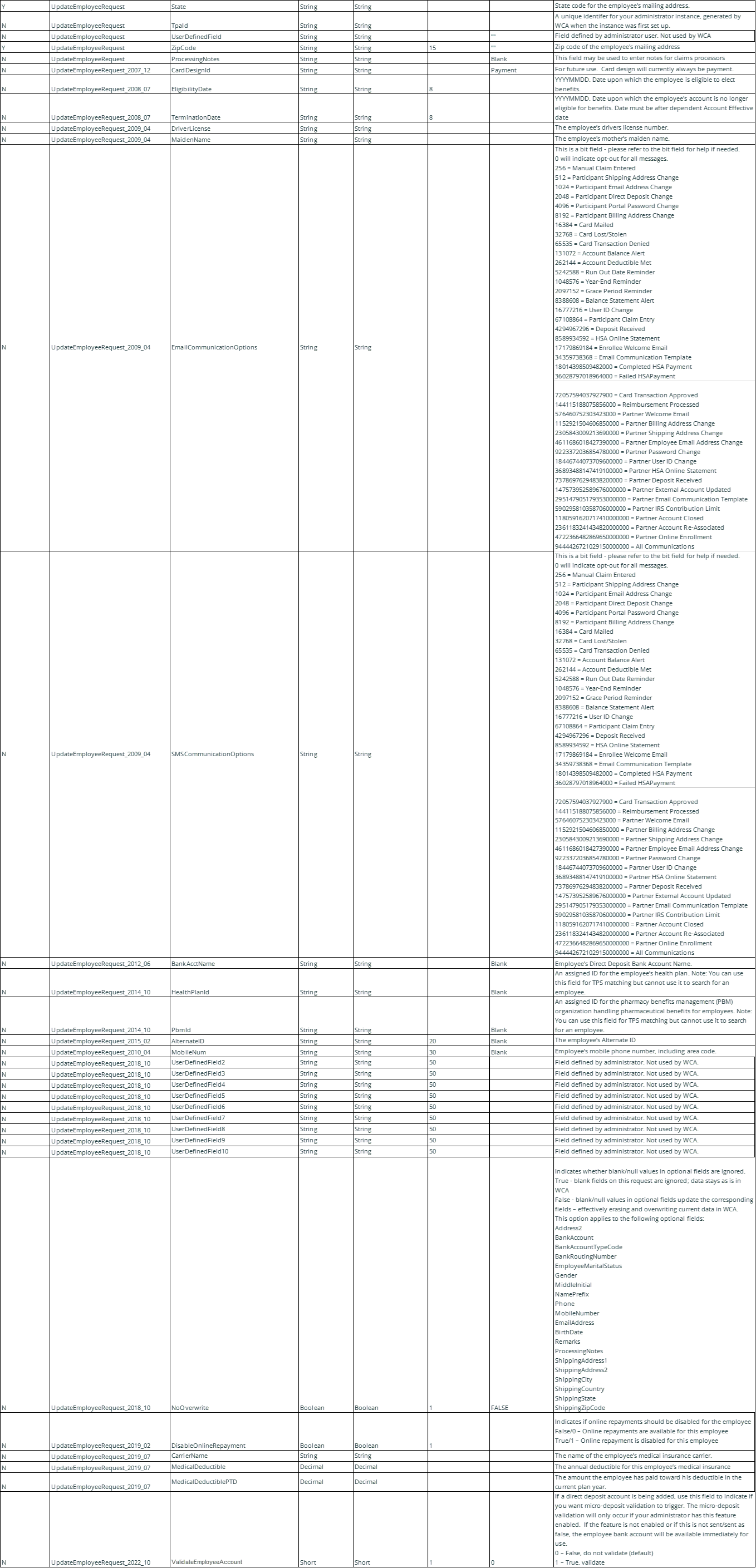
Response Message: Empty Message
Example of a UpdateEmployee SOAP request message
<?xml version="1.0" encoding="utf-8" ?>
<soap:Envelope xmlns:soap="http://schemas.xmlsoap.org/soap/envelope/"
xmlns:xsi="http://www.w3.org/2001/XMLSchema-instance"
xmlns:xsd="http://www.w3.org/2001/XMLSchema">
<soap:Header>
<MBISessionHeader xmlns="http://www.medibank.com/MBIWebServices/SoapHeader/">
<MBISessionID>jhcppu45zzo00y45cqi03r55</MBISessionID>
</MBISessionHeader>
</soap:Header>
<soap:Body>
<UpdateEmployee xmlns="http://www.medibank.com/MBIWebServices/Employee/Messages/Employee/Request/2004/06/">
<updateEmployeeRequest>
<Address1>123 Water</Address1>
<BankAccount>123455</BankAccount>
<BankAccountTypeCode xmlns="http://www.medibank.com/MBIWebServices/Enums/">Savings</BankAccountTypeCode>
<BankRoutingNumber>123456789</BankRoutingNumber>
<BirthDate>1976-01-01</BirthDate>
<City>World</City>
<CurrentEmployeeSocialSecurityNumber>444555666</CurrentEmployeeSocialSecurityNumber>
<EmailAddress />
<EmployeeMaritalStatus xmlns="http://www.medibank.com/MBIWebServices/Enums/">Divorced</EmployeeMaritalStatus>
<EmployeeStatus xmlns="http://www.medibank.com/MBIWebServices/Enums/">Active</EmployeeStatus>
<EmployerId>EASE10</EmployerId>
<FirstName>Movie</FirstName>
<Gender xmlns="http://www.medibank.com/MBIWebServices/Enums/">None</Gender>
<LastName>Doe</LastName>
<MiddleInitial />
<NamePrefix>Mr.</NamePrefix>
<Phone />
<ReimbursementCode xmlns="http://www.medibank.com/MBIWebServices/Enums/">Check</ReimbursementCode>
<Remarks>This is a test</Remarks>
<ShippingCountry />
<State>MA</State>
<TpaId>T00209</TpaId>
<ZipCode>34567</ZipCode>
</updateEmployeeRequest>
</UpdateEmployee>
</soap:Body>
</soap:Envelope>
Example of an UpdateEmployee SOAP response message
<?xml version="1.0" encoding="utf-8" ?>
<soap:Envelope xmlns:soap="http://schemas.xmlsoap.org/soap/envelope/"
xmlns:xsi="http://www.w3.org/2001/XMLSchema-instance"
xmlns:xsd="http://www.w3.org/2001/XMLSchema">
<soap:Header>
<MBIMessageIdHeader xmlns="http://www.medibank.com/MBIWebServices/SoapHeader/" />
</soap:Header>
<soap:Body>
<UpdateEmployeeResponse
xmlns="http://www.medibank.com/MBIWebServices/Employee/Messages/Employee/Response/2004/06/">
<UpdateEmployeeResult />
</UpdateEmployeeResponse>
</soap:Body>
</soap:Envelope>
Example Client Code
The following is an example of the client code (using a .NET proxy class for the service) used when calling the UpdateEmployee method.
try
{
// Create the session SOAP header in order to pass the Account Service
// the client’s current session ID.
mbiSessionHeader = new EmployeeServiceNameSpace.MBISessionHeader();
// Create proxy object for the Employee service
proxy = new EmployeeServiceNameSpace.EmployeeService();
// Create request message for method call (input parameters)
request = new EmployeeServiceNameSpace.UpdateEmployeeRequest();
// Set the input parameters
request.Address1 = _address1.Text;
request.Address2 = _address2.Text;
request.BankAccount = _bankAccount.Text;
request.BankAccountTypeCode = (EmployeeServiceNameSpace.BankAccountType)
_bankAccountTypeCode.SelectedItem;
request.BankRoutingNumber = _bankRoutingNumber.Text;
if(_birthDate.Text.Length > 0)
{
request.BirthDate = Convert.ToDateTime(_birthDate.Text);
}
request.City = _city.Text;
request.Country=_country.Text;
request.CurrentEmployeeSocialSecurityNumber = _empeCurrentSSN.Text;
request.EmailAddress = _email.Text;
request.EmployeeMaritalStatus = (EmployeeServiceNameSpace.MaritalStatus)
_maritalStatus.SelectedItem;
request.EmployeeStatus = (EmployeeServiceNameSpace.CardholderStatus)
_empeStatus.SelectedItem;
request.EmployerId = _emprId.Text;
request.FirstName = _firstName.Text;
request.Gender = (EmployeeServiceNameSpace.Gender)_gender.SelectedItem;
request.LastName = _lastName.Text;
request.MiddleInitial = _initial.Text;
request.NamePrefix = _namePrefix.Text;
request.NewEmployeeSocialSecurityNumber = _empeNewSSN.Text;
request.Phone = _phone.Text;
request.ReimbursementCode = (EmployeeServiceNameSpace.ReimbursementMethod)
_reimbursementCode.SelectedItem;
request.Remarks = _remarks.Text;
request.ShippingAddress1 = _shippingAddress1.Text;
request.ShippingAddress2 = _shippingAddress2.Text;
request.ShippingCity = _shippingCity.Text;
request.ShippingCountry = _shippingCountry.Text;
request.ShippingState = _shippingState.Text;
request.ShippingZipCode = _shippingZip.Text;
request.State = _state.Text;
request.TpaId = _tpaId.Text;
request.UserDefinedField = _userDefinedField.Text;
request.ZipCode = _zipCode.Text;
// session ID returned from login method
mbiSessionHeader.MBISessionID = _sessionId.Text;
proxy.MBISessionHeaderValue = mbiSessionHeader;
// Call the method
response = proxy.UpdateEmployee(request);
MessageBox.Show("Finished.");
}
catch(SoapException se)
{
// perform needed operations
}
catch(Exception ex)
{
// perform needed operations
}
__________________________________________________
SearchEmployee
This method is used to search for employee information.
History
The SearchEmployees methods are listed below:
Request Message
SearchEmployeesRequest
Response Message
SearchEmployeesResponse
SearchEmployees Request/Response Messages
The SearchEmployees method requires the following request and response messages (input and output data).
The table below includes the following request message:
SearchEmployeesRequest
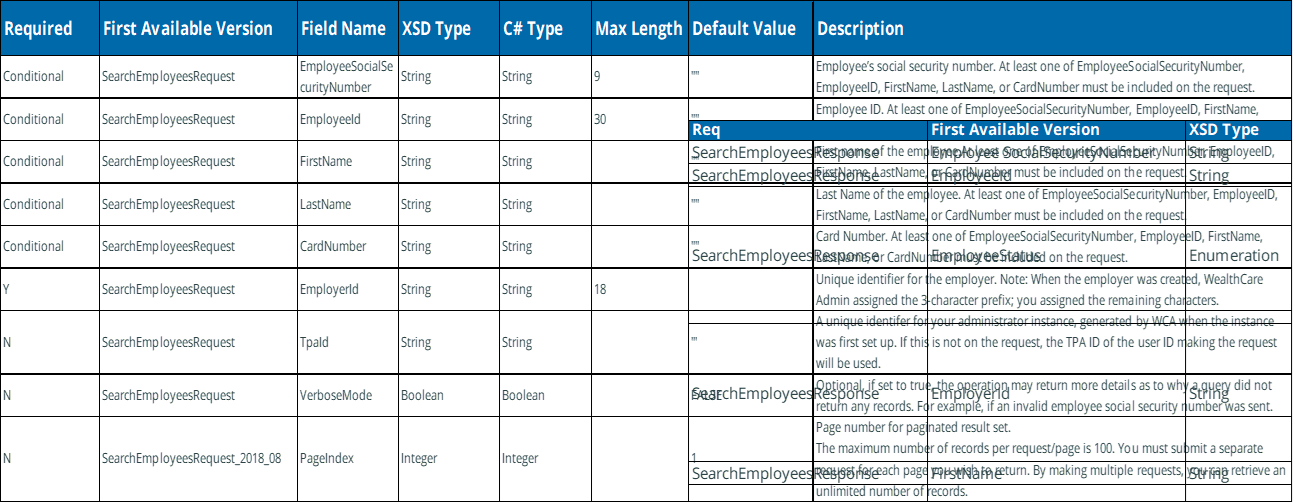
The table below includes the following response message:
SearchEmployeesResponse

Example of a SearchEmployees SOAP request message
<?xml version="1.0" encoding="utf-8" ?>
<soap:Envelope xmlns:soap=http://schemas.xmlsoap.org/soap/envelope/
xmlns:xsi="http://www.w3.org/2001/XMLSchema-instance"
xmlns:xsd="http://www.w3.org/2001/XMLSchema">
<soap:Header>
<MBISessionHeader xmlns="http://www.medibank.com/MBIWebServices/SoapHeader/">
<MBISessionID>jhcppu45zzo00y45cqi03r55</MBISessionID>
</MBISessionHeader>
</soap:Header>
<soap:Body>
<SearchEmployees xmlns="http://www.medibank.com/MBIWebServices/Employee/Messages/Employee/Request/2004/06/"> <searchEmployeesRequest>
<EmployeeSocialSecurityNumber>444555666</EmployeeSocialSecurityNumber>
<EmployerId>EASE10</EmployerId>
<iId>T00209</TpaId>
</searchEmployeesRequest>
</SearchEmployees>
</soap:Body>
</soap:Envelope>
Example of a SearchEmployees SOAP response message
<?xml version="1.0" encoding="utf-8" ?>
<soap:Envelope xmlns:soap=http://schemas.xmlsoap.org/soap/envelope/
xmlns:xsi="http://www.w3.org/2001/XMLSchema-instance"
xmlns:xsd="http://www.w3.org/2001/XMLSchema">
<soap:Header>
<MBIMessageIdHeader xmlns="http://www.medibank.com/MBIWebServices/SoapHeader/" />
</soap:Header>
<soap:Body>
<SearchEmployeesResponse xmlns="http://www.medibank.com/MBIWebServices/Employee/Messages/Employee/Response/2004/06/">
<SearchEmployeesResult>
<EmployeeSocialSecurityNumber>123981312</EmployeeSocialSecurityNumber>
<EmployeeId>XXX999</EmployeeId>
<EmployeeStatus xmlns="http://www.medibank.com/MBIWebServices/Enums/">New</EmployeeStatus>
<EmployerId>EASE10</EmployerId>
<FirstName>Pet</FirstName>
<Gender xmlns="http://www.medibank.com/MBIWebServices/Enums/">Male</Gender>
<LastName>Shop</LastName>
<EmployeeMaritalStatus xmlns="http://www.medibank.com/MBIWebServices/Enums/">Divorced</EmployeeMaritalStatus>
<MiddleInitial />
<NamePrefix>Mr.</NamePrefix>
<TpaId>T00209</TpaId>
</SearchEmployeesResult>
</SearchEmployeesResponse>
</soap:Body>
</soap:Envelope>
Example Client Code
The following is an example of the client code (using a .NET proxy class to connect to the service) used when calling the SearchEmployees method.
try
{
_dataset.Tables["Employees"].Clear();
// Create the session SOAP header in order to pass the Account Service
// the client’s current session ID.
mbiSessionHeader = new EmployeeServiceNameSpace.MBISessionHeader();
// Create proxy object for the Employee service
proxy = new EmployeeServiceNameSpace.EmployeeService();
// Create request message for method call (input parameters)
request = new EmployeeServiceNameSpace.SearchEmployeesRequest();
// Set the input parameters
request.EmployeeSocialSecurityNumber = _employeeSocialSecurityNumber.Text; request.EmployerId = _employerId.Text;
request.TpaId = _tpaId.Text;
request.VerboseMode = Convert.ToBoolean(_verboseMode.Text);
// session ID returned from logon method
mbiSessionHeader.MBISessionID = _sessionId.Text;
proxy.MBISessionHeaderValue = mbiSessionHeader;
response = proxy.SearchEmployees(request);
if(response != null)
{
_dataset.Tables["Employees"].Rows.Add(new string[]
{
response.EmployeeMaritalStatus.ToString(),
response.EmployeeSocialSecurityNumber,
response.EmployeeStatus.ToString(),
response.EmployeeId.ToString(),
response.EmployerId,
response.FirstName,
response.Gender.ToString(),
response.LastName,
response.MiddleInitial,
response.NamePrefix,
response.TpaId
});
}
}
catch(SoapException se)
{
// perform needed operations
}
catch(Exception ex)
{
// perform needed operations
}
__________________________________________________
UpdateEmployeeHumanResourceInfo
This method is used to add an employee’s non-discriminatory information.
History
The UpdateEmployeeHumanResourceInfo methods are listed below:
Request Message
UpdateEmployeeHumanResourceInfoRequest
Response Message
UpdateEmployeeHumanResourceInfoResponse Request/Response Messages
The UpdateEmployeeHumanResourceInfo method requires the following request and response messages (input and output data). The table below includes the following request message:
UpdateEmployeeHumanResourceInfoRequest

Response Message: Empty Message
Example of an UpdateEmployeeHumanResourceInfo SOAP request message
<?xml version="1.0" encoding="utf-8" ?>
<soap:Envelope xmlns:soap=32TUhttp://schemas.xmlsoap.org/soap/envelope/U32T
xmlns:xsi="http://www.w3.org/2001/XMLSchema-instance"
xmlns:xsd="http://www.w3.org/2001/XMLSchema">
<soap:Header>
<MBISessionHeader xmlns="http://www.medibank.com/MBIWebServices/SoapHeader/">
<MBISessionID>jhcppu45zzo00y45cqi03r55</MBISessionID>
</MBISessionHeader>
</soap:Header>
<soap:Body>
<UpdateEmployeeHumanResourceInfoRequest
xmlns="http://www.medibank.com/MBIWebServices/Employee/Messages/Employee/Request/">
<updateEmployeeHumanResourceInfoRequest>
<TpaId>T00133</TpaId>
<EmployeeId>Employee1</EmployeeId>
<EmployerId>WST5111</EmployerId>
<AddComp1>1000</AddComp1>
<OrigHireDte>20050103</OrigHireDte>
</updateEmployeeHumanResourceInfoRequest>
</UpdateEmployeeHumanResourceInfoRequest>
</soap:Body>
</soap:Envelope>
Example of an UpdateEmployeeHumanResourceInfo SOAP response message
<?xml version="1.0" encoding="utf-8" ?>
<soap:Envelope xmlns:soap="http://schemas.xmlsoap.org/soap/envelope/"
xmlns:xsi="http://www.w3.org/2001/XMLSchema-instance"
xmlns:xsd="http://www.w3.org/2001/XMLSchema">
<soap:Header>
<MBIMessageIdHeader xmlns="http://www.medibank.com/MBIWebServices/SoapHeader/" />
</soap:Header>
<soap:Body>
< UpdateEmployeeHumanResourceInfoResponse
xmlns="http://www.medibank.com/MBIWebServices/Employee/Messages/Employee/Response/">
< UpdateEmployeeHumanResourceInfoResult />
</ UpdateEmployeeHumanResourceInfoResponse>
</soap:Body>
</soap:Envelope>
Example Client Code
The following is an example of the client code (using a .NET proxy class to connect to the service) used when calling the UpdateEmployeeHumanResourceInfo method.
try
{
//declare the request and response objects
SmokeTest.Employee_2007_08.UpdateEmployeeHumanResourceInfoRequest req_2007_08;
SmokeTest.Employee_2007_08.UpdateEmployeeHumanResourceInfoResponse resp_2007_08;
SmokeTest.Employee_2007_08.MBISessionHeader es_2007_08_sh;
//Create objects
es_2007_08_proxy = new SmokeTest.Employee_2007_08.EmployeeService();
es_2007_08_sh = new SmokeTest.Employee_2007_08.MBISessionHeader();
req_2007_08 = new SmokeTest.Employee_2007_08.UpdateEmployeeHumanResourceInfoRequest();
//Required fields
req_2007_08.TpaId = txtTPA.text;
req_2007_08.EmployerId = txtEmployerId.text;
req_2007_08.EmployeeId = txtEmployeeId.text;
req_2007_08.AddComp1 = txtAddComp1.text;
req_2007_08.AddComp2 = txtAddComp2.text;
es_2007_08_sh.MBISessionID = sSession;
es_2007_08_proxy.MBISessionHeaderValue = es_2007_08_sh;
resp_2007_08 = es_2007_08_proxy.UpdateEmployeeHumanResourceInfo(req_2007_08);
}
catch(Exception ex)
{
//If an exception occurred, display to the user txtResponse.Text = ex.Message;
}
}
__________________________________________________
GetEmployeeHumanResourceInfo
This method is used to get an employee’s non-discriminatory information.
History
The GetEmployeeHumanResourceInformation methods are listed below:
Request Message
GetEmployeeHumanResourceInfoRequest
Response Message
GetEmployeeHumanResourceInfoResponse_2020_02
GetEmployeeHumanResourceInfoResponse Request/Response Messages
The GetEmployeeHumanResourceInfo method requires the following request and response messages (input and output data). The table below includes the following request message:
GetEmployeeHumanResourceInfoRequest
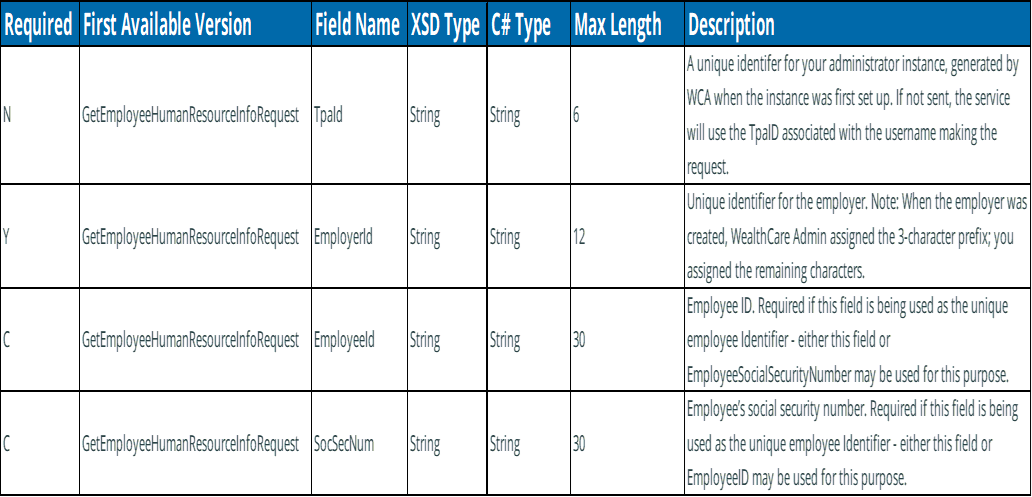
The table below includes the following response message:
GetEmployeeHumanResourceInfoResponse_2020_02
GetEmployeeHumanResourceInfoResponse

Example of a GetEmployeeHumanResourceInfo SOAP request message
<?xml version="1.0" encoding="utf-8" ?>
<soap:Envelope xmlns:soap=32Thttp://schemas.xmlsoap.org/soap/envelope/32T
xmlns:xsi="http://www.w3.org/2001/XMLSchema-instance"
xmlns:xsd="http://www.w3.org/2001/XMLSchema">
<soap:Header>
<MBISessionHeader xmlns="http://www.medibank.com/MBIWebServices/SoapHeader/">
<MBISessionID>jhcppu45zzo00y45cqi03r55</MBISessionID>
</MBISessionHeader>
</soap:Header>
<GetEmployeeHumanResourceInfoRequest xmlns="http://www.medibank.com/MBIWebServices/Employee/Messages/Employee/Request/">
<getEmployeeHumanResourceInfoRequest>
<TpaId>T00123</TpaId>
<EmployeeId>Employee1</EmployeeId>
<EmployerId>WST1234</EmployerId>
</getEmployeeHumanResourceInfoRequest>
</GetEmployeeHumanResourceInfoRequest>
</soap:Body>
</soap:Envelope>
Example of a GetEmployeeHumanResourceInfo SOAP response message
<?xml version="1.0" encoding="utf-8" ?>
<soap:Envelope xmlns:soap="http://schemas.xmlsoap.org/soap/envelope/"
xmlns:xsi="http://www.w3.org/2001/XMLSchema-instance"
xmlns:xsd="http://www.w3.org/2001/XMLSchema">
<soap:Header>
<MBIMessageIdHeader xmlns="http://www.medibank.com/MBIWebServices/SoapHeader/" /> <MessageId>36565d89-7619-
48be-8c7e-7fb1929d0ded</MessageId></MBIMessageIdHeader>
</soap:Header>
<soap:Body>
<GetEmployeeHumanResourceInfoResponse
xmlns="http://www.medibank.com/MBIWebServices/Employee/Messages/Employee/Response/"><GetEmployeeHumanResourc
eInfoResult>
<AddComp1>70</AddComp1>
<AddComp2>20</AddComp2>
<BaseSalary>95000</BaseSalary>
<BranchCde />
<Cobra>false</Cobra>
<CompOfficer>false</CompOfficer>
<CompOfficerDca>false</CompOfficerDca>
<HireDte />
<OrigHireDte />
<TermDte />
<EligDte />
<OccupCde />
<LocCde />
<DeptCde />
<DivisionKey>-1</DivisionKey>
<SecCde />
<HealthId />
<EvidInsurability />
<HcRelativeSsn/>
<PrevYrTotalComp>0</PrevYrTotalComp>
<StockPct>0</StockPct>
<VacationDays>0</VacationDays>
<UnionMember>false</UnionMember>
<Smoker>false</Smoker>
<NonResidentAlien>false</NonResidentAlien>
<TaxFilingStatusCde>Single</TaxFilingStatusCde>
<EmployTypeCde>FullTime</EmployTypeCde>
<EmpeOptioncde>Total</EmpeOptioncde>
<KeyEmpe>false</KeyEmpe>
<SpouseDepOfOwner>false</SpouseDepOfOwner>
<ElectOtherAmt>0</ElectOtherAmt>
<ElectHealthAmt>0</ElectHealthAmt>
<ElectDentalAmt>0</ElectDentalAmt>
<ElectVisionAmt>0</ElectVisionAmt>
<ElectGrpTermLifeAmt>0</ElectGrpTermLifeAmt>
<ElectOtherHealthAmt>0</ElectOtherHealthAmt>
<ElectLtdAmt>0</ElectLtdAmt>
<ElectStdAmt>0</ElectStdAmt>
<ElectAdoptionAmt>0</ElectAdoptionAmt>
<Elect401kAmt>0</Elect401kAmt>
<ElectHealthFSAAmt>0</ElectHealthFSAAmt>
<ElectDependentcareFSAAmt>0</ElectDependentcareFSAAmt>
<TotalElectAmt>0</TotalElectAmt>
<HcOverride>False</HcOverride>
</GetEmployeeHumanResourceInfoResult>
</GetEmployeeHumanResourceInfoResponse>
</soap:Body>
</soap:Envelope>
Example Client Code
The following is an example of the client code (using a .NET proxy class to connect to the service) used when calling the GetEmployeeHumanResourceInfo method.
try
{
//declare the request/response objects
SmokeTest.Employee_2007_08.GetEmployeeHumanResourceInfoRequest req_2007_08;
SmokeTest.Employee_2007_08.GetEmployeeHumanResourceInfoResponse resp_2007_08;
//Create objects
SmokeTest.Employee_2007_08.MBISessionHeader es_2007_08_sh;
//Create objects
es_2007_08_proxy = new SmokeTest.Employee_2007_08.EmployeeService();
es_2007_08_sh = new SmokeTest.Employee_2007_08.MBISessionHeader();
req_2007_08 = new SmokeTest.Employee_2007_08.GetEmployeeHumanResourceInfoRequest();
//Required fields
req_2007_08.TpaId = txtTPA.text;
req_2007_08.EmployerId = txtEmployerId.text;
req_2007_08.EmployeeId = txtEmployeeId.text;
//Display session ID on web form
es_2007_08_sh.MBISessionID = sSession;
es_2007_08_proxy.MBISessionHeaderValue = es_2007_08_sh;
resp_2007_08 = es_2007_08_proxy.GetEmployeeHumanResourceInfo(req_2007_08);
}
catch (Exception ex)
{
txtResponse.Text = ex.Message;
}
}
__________________________________________________
AddEmployeeInteraction
This method is used by administrators to add employee interactions.
History
The AddEmployeeInteraction methods are listed below:
Request Messages
AddEmployeeInteraction
Response Messages
AddEmployeeInteraction
AddEmployeeInteractions Request/Response Messages
The AddEmployeeInteraction method requires the following request and response messages (input and output data). The table below includes the following request messages:
AddEmployeeInteractionRequest
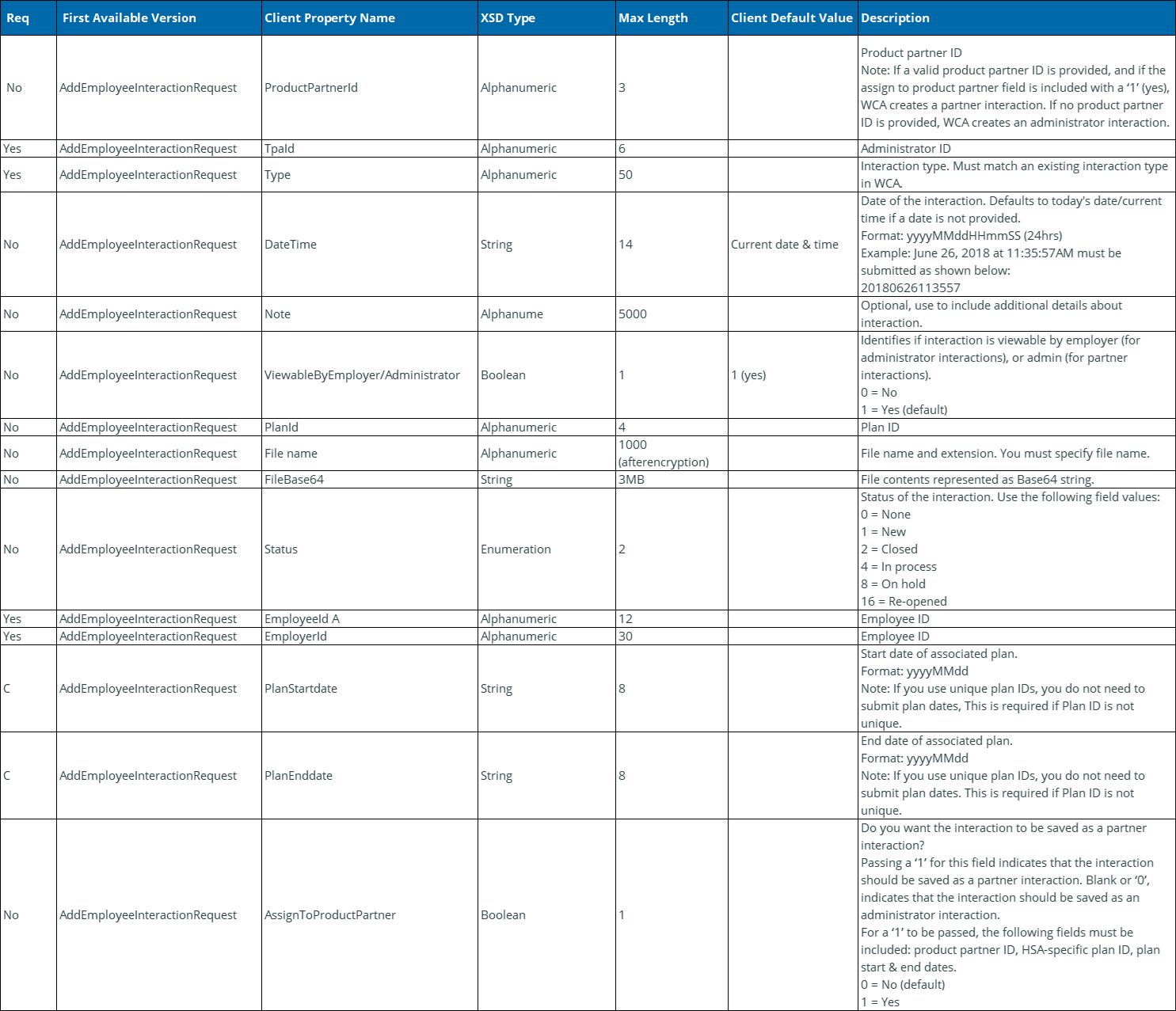
Response message:

Copyright © 2023 Alegeus Technologies, LLC. All rights reserved. Alegeus, Alegeus Technologies, WealthCare, WealthCare Saver are registered trademarks of Alegeus Technologies, LLC